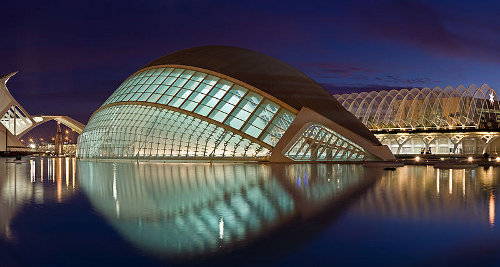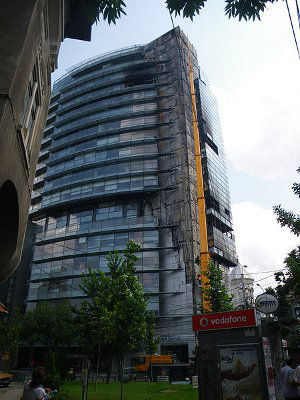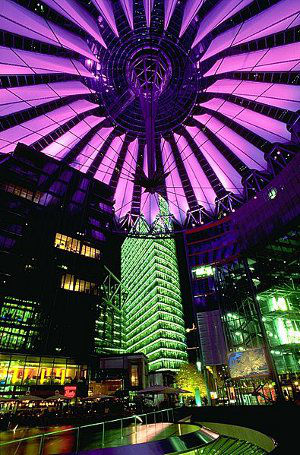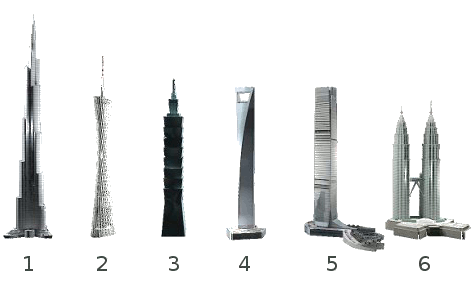Construction insurance and innovation
 City of Arts and Sciences, Valencia, Spain © David Iliff, CC BY-SA 3.0
City of Arts and Sciences, Valencia, Spain © David Iliff, CC BY-SA 3.0Competition, the first driver of innovation
Today, it is the cities and companies which are most keen on architectural innovation. By initiating programs to build original buildings designed to promote their image, Dubai, Shanghai and soon Qatar took over New York, Chicago and Paris: the tallest towers, trendiest airports, nicest museums, most friendly stadiums, and the most ecological headquarters.
Past know-how is no longer sufficient. To meet market needs, manufacturers have invested heavily in research. They have developed innovative products with nanotechnology at the core of materials, development of concrete types and evolution of components. It is with these materials that more impressive buildings are built.
Renowned architects and design offices are in search of eye-catching projects. They are out to meet the challenges posed by governments, cities and companies and to seek large structures that could strengthen their image by benefiting from the economic fallout and tourist flows: This is the "Bilbao effect".
Environment, the second driver of innovation
 Allianz Arena © Maximilian Dörrbecker, CC BY-SA 2.5 Allianz Arena © Maximilian Dörrbecker, CC BY-SA 2.5 |
Environmental friendliness is a recent must for society. Often imposed by legislation, this approach resulted in energy and raw material savings and reduction of greenhouse gases. Environmental protection also entails a cost, and very seldom does a project owner increase spending on environmental grounds. Quite often it is the law which compels owners to comply with new rules, particularly in developed countries where environmental requirements are more stringent.
Insurers and innovation
Insurers are often reluctant to cover construction risks using new materials and innovative architectural designs.
 Bergisel Jump Springboard by Zaha Hadid Bergisel Jump Springboard by Zaha Hadid |
While common techniques and conventional materials have long been trusted by insurers, it is a totally different story for new materials that are used for the first time.
Insurers usually intervene at two particular stages in the life of a project: once to cover the construction itself and a second time to offset the disruptions which may occur after admission of the project.
Construction insurance
When underwriting a contract, the policyholder, usually the builder, is required to inform the insurer about the use of uncommon techniques. The insured is obliged, under penalty of law, to specify any kind of innovation in the risk declaration form. This statement stands as a contractual obligation.
The use of new pioneer architectural materials and/or techniques has only added a new constraint.
The insurer will analyze the impact of novelty during the construction phase. Innovation can involve all or part of the project. Very rarely does it concern the entire construction program. After reviewing the case, the insurer may exclude certain risks or damages to parts of the work or to the property. Some exclusions may be temporary and, therefore, disappear provided that the construction does not sustain any failure at a given period of time.
The insurer may also limit its liability per claim and per insurance period. It can use high deductibles so as to get the insured involved in the risk taking.
 For very complex works, the involvement of one or more consultants and experts is required.
For very complex works, the involvement of one or more consultants and experts is required.
It is common for non-standard sites to be presented to the insurer. This applies, for instance, to the Khalifa Tower in Dubai, the entire Palm Island housing complex also in Dubai, the Bilbao museum (Spain) or to the Confluence museum in Lyon (France). These works, often prototypes in bold shapes, defy the laws of construction. Delays in obtaining insurance and reinsurance coverage are likely to affect such projects.
Blockages are usually not definitive. Further scientific analyses are conducted and in some rare cases, abandonment of innovation is necessary.
Repair of damages consecutive to the reception of work
 To protect buyers of real estate and moralize the construction market, some countries like France, Sweden, Finland, Spain, Italy, Denmark and the Maghreb countries require the underwriting of a decennial or a long term insurance policy. This policy covers damages occurring after admission of the work. All stakeholders taking part in the construction process are subject to this requirement. In France, the law requires builders to purchase this cover before the start of construction, hence, the blocking of highly innovative projects and the lengthy and difficult negotiations between builders and insurers.
To protect buyers of real estate and moralize the construction market, some countries like France, Sweden, Finland, Spain, Italy, Denmark and the Maghreb countries require the underwriting of a decennial or a long term insurance policy. This policy covers damages occurring after admission of the work. All stakeholders taking part in the construction process are subject to this requirement. In France, the law requires builders to purchase this cover before the start of construction, hence, the blocking of highly innovative projects and the lengthy and difficult negotiations between builders and insurers.
In some countries professional liability insurance is required for architects and designers.
The Roissy Charles de Gaulle 2E terminal: partial collapse
In June 2004, part of Terminal 2E at Roissy Charles de Gaulle airport (Paris) collapsed, killing four people. The investigation revealed that the original shape of the building and the unknown non-conventional method used seem to be behind this accident. The cost of rebuilding the destroyed area was estimated at 150 million EUR (204 million USD) and was supported by insurers (Axa and Groupama-Gan) and reinsurers (Swiss Re, Munich Re, Scor and General Re).
Hassan II Mosque in Morocco: in danger of collapse
Inaugurated in 1993, the Hassan II Mosque, the third largest mosque in the world, whose work lasted 7 years and cost nearly 2 billion USD, is undergoing premature aging. Partly perched on the sea and subject to very severe climatic constraints (swell, humidity, ...), the mosque sustained dramatic deterioration: cracks, concrete spalling, and dilapidating pillars only five years after its inauguration.Insurance in support of innovation
 © Andreas Tille, CC BY-SA 3.0 © Andreas Tille, CC BY-SA 3.0 |
Despite some reservations, insurance does not stand as an obstacle to architectural innovation and remains an essential component of the construction process.
A survey conducted in Japan analyzing thirty-eight insurance schemes in the world, showed that insurance is a regulator of the construction business
For a more active support of insurance to innovation, national regulations are required to back up the construction sector by:
- setting up a directory of new products or innovative systems that are tested and recognized by scientific centers and building experts,
- centralizing technical bodies entrusted with marking and certification,
- conducting a joint international study designed to identify good practices and introduce innovations based on their actual effectiveness, cost reduction and reliability,
- establishing standard insurance contracts.
Qatar: a project of nine air-conditioned stadiums in the middle of the desert
Qatar will host the 22nd World Cup football in 2022. This rich emirate plans to build nine large ultramodern stadiums and endow them along with the other already existent ones with an air conditioning system powered by solar energy. Temperatures inside the stadium should be kept near 20°C. The cost of the building and renovation of stadiums, which will be ready in 2014, is estimated at 4 billion USD.
After the end of the competition, the stadiums will be dismantled and offered to football federations in difficulty.
Bionic Tower in Shanghai: a futuristic project
Another extravagant project could see the light of day in Shanghai. This is a vertical city where 100 000 people will be housed in a bionic 300-storey and 1220-metre-high tower. The work will be surrounded by a set of operative building (offices, shops, hotels, hospitals, recreational facilities, parks, etc). This project, which will be built on an artificial island, is going to cost 15 billion USD.
The world’s tallest towers
 in billions USD
in billions USD| Tower name | Country | Construction budget | Height | Number of floors | |
|---|---|---|---|---|---|
1 | Burj Khalifa | United Arab Emirates, Dubai | 1.5 | 828 meters | 162 |
2 | Canton Tower | China,Guangzhou | NA | 610 meters | 37 |
3 | Taipei 101 | Taiwan, Taipei | 1.76 | 508 meters | 101 |
4 | World Financial Centre | China, Shanghai | 1.2 | 492 meters | 127 |
5 | International Commerce Center | China, Hong Kong | NA | 484 meters | 118 |
6 | Petronas Towers | Malaysia, Kuala Lumpur | 1.6 | 452 meters | 88 |
Burj Khalifa at Dubai: tower of extravagance
It is the tallest tower in the world with 828 meters in height and about 162 floors. Its final cost amounted to 1.5 billion USD. More than 12 000 workers took part in this project whose construction began in 2004 and ended in January 2010. A month after its inauguration, the tower had to deal with power supply problems.